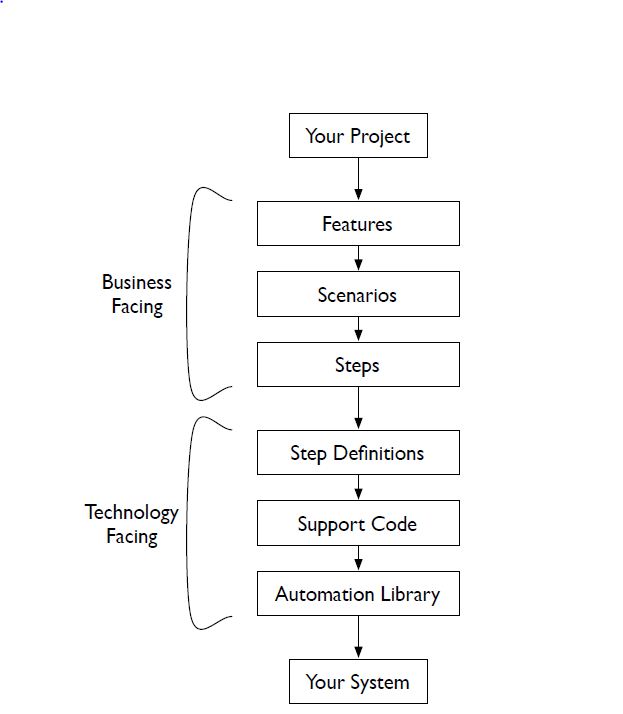CSC/ECE 517 Fall 2012/ch1 1w3 pl: Difference between revisions
| Line 62: | Line 62: | ||
==Cucumber Testing Stack== | ==Cucumber Testing Stack== | ||
/* Some Content */ | |||
[[File:Cucumber.JPG|500px|thumb|right|alt Cucumber Testing Stack]] | [[File:Cucumber.JPG|500px|thumb|right|alt Cucumber Testing Stack]] | ||
==Advantages of Cucumber== | |||
Advantages of Cucumber | |||
*Specifications can be written in more than forty different spoken languages | |||
*Cucumber helps build bridges between the technical and nontechnical members of a software team | |||
*Cucumber tests can be easily read and written by business stakeholders | |||
*Writing Cucumber tests are quick , easy , efficient and understable. | |||
Revision as of 22:45, 13 September 2012
Unit-Testing Frameworks for Ruby: Cucumber
This wiki-page serves as a knowledge source for understanding Unit-Testing Frameworks available for Ruby particularly Cucumber .
Introduction
Unit testing is a software development process for testing individual units of source code independently for proper operation [1]. An unit testing framework helps the process of unit testing by automating the test cases which are written to ensure the correctness of the system . Ruby provides a framework in its standard library for setting up, organizing, and running tests called Test::Unit [2]. Other testing framework available for ruby are Shoulda, RSpec, Cucumber.
Cucumber
Cucumber is one of the latest unit test frameworks to have come for Ruby as part of the RSpec family of tools. Cucumber is written in the Ruby programming language and adheres to behaviour driven development(BDD). Behaviour Driven Development is an Agile Development process that comprises aspects of Acceptance Test Driven Planning , Domain Driven Design and Test Driven Development (TDD). Cucumber is designed specifically to ensure the acceptance tests can easily be read and written by anyone.
Behaviour Driven Development(BDD)
BDD preserves the basic iterative (fail-pass) workflow of TDD, but stresses on specifying behaviors that are understandable to people (say from non programming background). In this approach we write tests in a natural language such that even a non programmer can understand.
Acceptance Test
Acceptance Test Drive Planning is practice that stresses on the importance of the identifying the functions and requirements of the software beforehand so that we exactly get to know when our development phase is over. This practice results in fewer bugs , shorter delivery times and great customer satisfaction.
Cucumber Acceptance Test
Feature: Sign up
Sign up should be quick and friendly.
Scenario: Successful sign up
New users should get a confirmation email and be greeted personally by the site once signed in.
Given I have chosen to sign up
When I sign up with valid details
Then I should receive a confirmation email
And I should see a personalized greeting message
Scenario: Duplicate email
Where someone tries to create an account for an email address that already exists.
Given I have chosen to sign up
But I enter an email address that has already registered
Then I should be told that the email is already registered
And I should be offered the option to recover my password
Acceptance tests written in this style are more than just tests; they are executable specifications. As of January 2012, Cucumber was the second most popular testing framework after RSpec for Ruby
How Cucumber works
Cucumber is a command-line tool. It reads in specifications from plain-language text files called features, examines them for scenarios to test, and runs the scenarios against your system. The feature files should be written according to specific syntax rules called Gherkin. Along with the features, you give Cucumber a set of step definitions, which map the business-readable language of each step into Ruby code to carry out whatever action is being described by the step
Cucumber takes customer understandable user stories as input and does integration and acceptance tests on the system by using the user stories as its input. Cucumber acts as the bridge between the customer and the developer. User stories are customer understandable but at the same time can be used to create test cases from it. This does pose some restrictions on the user stories that are written.
Feature
A high level statement of the what the test case actually does and there is only one feature per user story.
Scenario
A Scenario consists of one or more steps which describe about the various actions performed by the user with respect to this particular feature. There can be one or more scenarios per feature in a user story. A feature usually contains 3 to 8 steps in it. The Steps of the scenario always begin with one of the below mentioned key words :
1. Given : Steps that begin with given represent the state of the world before an event.(preconditions)
2. When : Steps that represent the event.
3. Then : Steps that represent the expected outcome.
4. And and But : Steps that extend the previous step.
Step Definition
/* Content */
Cucumber Testing Stack
/* Some Content */

Advantages of Cucumber
Advantages of Cucumber
- Specifications can be written in more than forty different spoken languages
- Cucumber helps build bridges between the technical and nontechnical members of a software team
- Cucumber tests can be easily read and written by business stakeholders
- Writing Cucumber tests are quick , easy , efficient and understable.